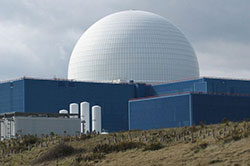 You shouldn’t, of course, believe what you read in the papers. This is a good general rule, but recently we had a rather striking example. On Feb 11th, The Times ran an article entitled, “”Electric cars mean UK could need 20 new nuclear plants””.
You shouldn’t, of course, believe what you read in the papers. This is a good general rule, but recently we had a rather striking example. On Feb 11th, The Times ran an article entitled, “”Electric cars mean UK could need 20 new nuclear plants””.
Here’s an extract, talking about a Transport for London report:
The analysis, seen by The Times, says that moving to an electric or hydrogen vehicle fleet “”has implications for London’s energy supply system””. At the maximum level of uptake in the city green cars would demand between seven and eight gigawatt-hours per year. Experts said this was equivalent to the output of more than two nuclear power stations similar to that being built at Hinkley Point in Somerset. Extrapolated nationally, it would require the equivalent of 20 new nuclear power stations nationwide.
That’s a pretty memorable number – 20 new nuclear power stations! – and indeed, a family member who had seen it asked me about it, knowing my interest in the topic.
The trouble is, it’s just plain wrong. It was repeated in The Daily Mail, too, and Mail readers, bless them, are even less likely to have the critical faculties to question the headline…
I did some back-of-the-envelope calculations and things looked fishy, and it turns out that the original article is full of mathematical errors and lack of understanding. The first, and biggest, is that seven gigawatt-hours-per-year is not the same as seven gigawatts! Two Hinkley Points would indeed produce about 7 GW, but that is 7 gigawatt-hours-per-hour, not -per-year! So they were out by a factor of about 6000 immediately. However, many of the other figures quoted were also incorrect (some of them in the other direction).
If you’re interested in the real numbers, David Pellow’s letter to the Editor gives a much better analysis, but a quick summary is that yes, of course, we will need some more power generation when all of the UK’s 31M cars are electric, but if those cars are mostly charged overnight during off-peak periods, we could handle about 20M of them already just using the current power network.
This whole area is rather a fun topic, actually, and takes us into the realms of smart grids, home solar, grid-scale storage made from recycled batteries, and so forth. Cars are remarkably flexible about when, and how fast, they are charged, making them ideal for absorbing excess power and smoothing out the fluctuations of demand and of renewable generation. One day last year, Germany’s renewable sources of electricity produced so much power that they actually paid people to use it, and the problem of dealing with the peaks and troughs of demand is something that the power grids have had to struggle with for decades. Cars can actually help with this.
But I digress. What I actually wanted to talk about were a few other things that struck me about this story:
-
The Times has since published a brief retraction in the small print. I doubt this will remove the ’20 power stations’ idea from many people’s minds, though. Wasn’t there a proposal once that such corrections should be given the same font sizes and number of column inches as the original article? When I’m an MP, I’ll propose a bill to that effect…
-
The online version of the article has been edited to remove the dramatic claims, though the URL still reveals the original embarrassing headline. I can’t decide whether this is an admirable admission of error, or an attempt to rewrite history and pretend it never happened. What do you think?
-
The Daily Mail’s version of the story is still online, and I don’t believe they’ve published a correction at all. Should they be required to do so, when they were repeating another paper’s story which has since been retracted?
Recent Comments